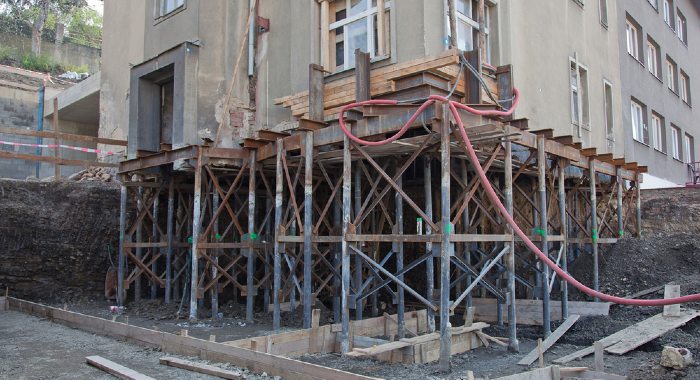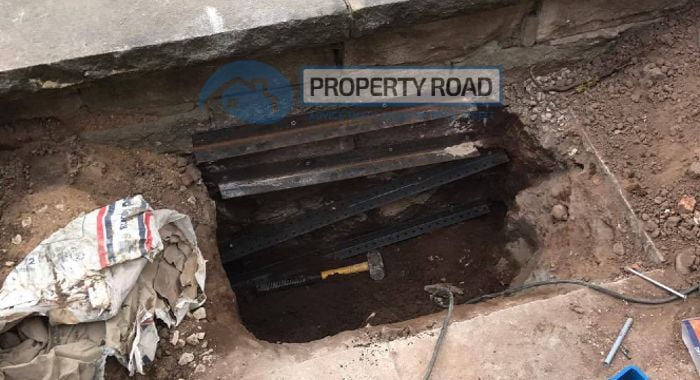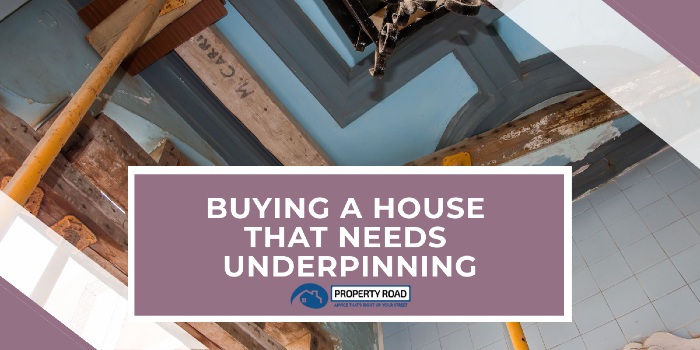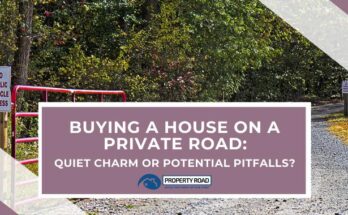There may be some issues about buying a house that needs underpinning, and it’s not just the risk that comes with living in a property being riddled with cracks, but also the impact on its future value.
The first thing to understand if you are buying a property that needs to be underpinned is that you must get a full structural survey carried out.
An experienced surveyor will be able to tell you just how serious the problem may be for underpinning to be considered and what the future issues will be to affect the property.
It’s also important that if you fall in love with a particular house, that you do not panic when someone mentions that it needs underpinning. That’s because:
- Subsidence is a common issue in some areas;
- There will be buyers who are not concerned about buying a property that needs to be underpinned.
It’s also important to appreciate that when buying a property that needs underpinning, that it may not have suffered from subsidence at all – though you will need the survey to highlight what the exact problem is.
This was something we faced when we found our dream home but a homebuyers report indicated there was subsidence and the property probably needed underpinning.
We had a structural survey carried out and the surveyor said the movement was long-standing and non-progressive and that underpinning wasn’t necessary. Therefore our experience shows a structural survey is well worth the money!
Other problems when buying a house in need of underpinning include finding an insurer willing to insure a house that has been underpinned.
It’s also a good idea to obtain buildings insurance from the moment you exchange contracts, rather than waiting until you move into the property.
What is underpinning?

For those who may not know, underpinning is the renovation or construction to strengthen a building’s current foundation to make it safe.
There are a range of reasons why underpinning may be necessary, for example, the property’s original foundation may no longer be stable or strong enough to support the property.
The underpinning process usually means excavating soil from beneath the property because this space will be needed for the underpinning works to take place.
And when a property moves on its foundations it is called subsidence, and it is the foundations that will need to be repaired.
It’s important to appreciate that once a property has been diagnosed with subsidence, it will affect the premiums for your building’s insurance.
However, you may struggle to find insurance but there are insurers out there who will insure against subsidence.

While our property didn’t need underpinning, we decide to do some work to strengthen the retaining wall next to the property as a precaution.
We used a technique similar to underpinning as we dug a big hole next to the wall and filled it with concrete. This had the effect of ensuring the property didn’t subside any further.
How to spot subsidence
The effects of subsidence are very easy to spot and, when you see the tell-tale signs, you must act immediately and seek professional advice from a surveyor.
If you are buying a house that needs underpinning, the most obvious sign of subsidence is for cracks to appear in the brickwork because the home’s structure is sinking on one side and putting strain on the other side.
This can occur because clay soil can shrink or shift or even crack during dry weather, leading to the foundations of a property sinking.
Drought areas are more prone to subsidence because of this – and so are older homes which tend to have shallower foundations, particularly if they are built with soft lime mortar and bricks.
Other causes for subsidence include local mining activity, or if the mine is no longer in operation the mine shaft may collapse and some quarrying sites can lead to instability in nearby homes.
Also, you also may find that a leaking drainpipe is washing or softening the soil underneath your home, so the weight of your property is compacting the soil – and then leaning on one side.
Have you got subsidence in your home?

There are some tell-tale signs for subsidence, though you need to be wary that this isn’t natural shrinkage of materials, or if yours is a new property that it may still be settling.
Some properties are also susceptible to humidity and temperature changes.
Essentially, if the crack in your property has been caused by subsidence, it will be:
- Visible externally and internally;
- Thicker than a £1 coin (or 3 mm);
- The crack will be wider at the top than at the bottom;
- Cracks will appear near windows and doors.
One easy trick to find out whether your home has subsidence is to see whether a £1 coin will fit into a crack.
Other signs for property subsidence include:
- Windows and doors do not fit or work properly;
- The wallpaper will crinkle at the ceiling or wall joints;
- There are cracks where an extension is joining the property.
Having bought several properties in former mining areas, we are quite used to finding cracks in our property. The £1 coin trick has always served us well and we generally find that most cracks looks much worse than they actually are.
However, whenever we have found a crack we are not sure about, we’ve always employed a structural engineer to check it out properly.

In our experience, surveyors doing homebuyers reports can sometimes exaggerate problems to cover their own backs. They can make cracks sound like major issues that will need a lot of work.
Structural surveyors, on the other hand, are specialists in subsidence and often back their advice with legal guarantees. The key words you’re looking for is that the any subsidence is ‘not-significant’ and ‘non-progressive’ or ‘historical’.
What to do next
If you believe your property is subsiding, then you must contact your insurer immediately.
It is they who will arrange for a full survey to be carried out and the surveyor will then confirm whether or not there is a case of subsidence.
Most insurance policies will cover you against subsidence and heave but there are some exclusions, usually covering demolition or construction or the use of defective building materials.
Some insurers may insist that the problem is monitored and will have sensors installed to find out what is causing the problem.
These sensors will track how quickly your property is subsiding.
However, you also need to be aware that this could take up to two years to resolve.
What is underpinning?
There are several methods when it comes to underpinning a property, and it’s important that these are carried out properly by professionals. Not carrying out underpinning correctly may lead to:
- Further damage to the property;
- Your property collapsing.
It’s important that you do not put off underpinning work because while it’s not a cheap exercise to carry out – it will become more expensive if you delay.
That said, don’t be too afraid of underpinning either. While serious issues can need be expensive to fix, we’ve had builders tell us that smaller problems are not actually that bad.
Essentially, the builders just have to dig down to the foundations and pour in concrete to shore up the foundations where they are sinking. The issue is that care has to be taken not to damage the foundations further, and you can only do a small part at a time.
That’s why you’ll find small problems aren’t that bad to fix, but problems covering a larger area can get expensive. A lot will depend on what’s caused the subsidence in the first place.
Buying A Property? FREE Step-By-Step Platform
Buying a property with subsidence
Here is the Property Road checklist for buyers who want to a buy a property with subsidence.
Mortgage surveys

It’s important to have a full structural survey carried out before you put in your offer.
This needs to be more than the basic survey that a mortgage lender may require.
This is what we did when we were buying a house with possible subsidence. It hadn’t been requested by our mortgage lender (as their survey didn’t pick up any issues) but we had it done for our own peace of mind following a homebuyers report.
Cost
If the survey highlights that there is a subsidence problem, you’ll need to take action.
The first step is to get any remedial works costed and then reduce your offer to buy that will take these costs into account.
A house seller will understand why the price has been reduced and if they reject your offer, they run the risk of struggling to sell their property.
History of subsidence
You also need to find out if there is a history of subsidence because you may find it hard to insure the property if so.
Some insurers will not offer insurance on a property with underpinning, and if they do, you’ll find that the premiums are higher.
You may also be asked to pay a higher excess in any future claim.
Insurance policies
You should check the insurance policy to see if there is a condition over subsidence and the location of any trees.
If there are trees close to the property these may be the source of any potential subsidence causes.
Future buyers
While buying a property that needs underpinning is not a huge issue, you need to be prepared that you may struggle to sell your property in future.
That’s because most buyers will be cautious about buying a property that has either been underpinned or needs underpinning.
Tips for sellers with a subsidence property
While we have looked at the issues concerning buyers wanting a house that is in need of underpinning, if you are trying to sell a subsidence property, then there are some issues for you too. They include:
Be honest

If there is a history of subsidence for your property, you should not consider keeping this fact from a prospective buyer.
You will need to offer full disclosure or face the prospect of being handed a bill for underpinning.
In our case, as we had a structural survey that indicated the cracks were nothing to worry about, we made sure this survey was available to any prospective buyers.
Whenever someone viewed the property we always mentioned we had had the crack checked and it was all OK and could provide the report. While this may highlight something the buyer hadn’t even seen, we felt this was a better approach then just hoping they hadn’t noticed!
When we had accepted an offer and they were having a homebuyers survey done, we gave a copy of the structural engineer report to the surveyor. They were very grateful for this and hardly even mentioned in the cracks in their report as a result!
Subsidence is present
You need to check at the first signs of subsidence if there are cracks in the brickwork or plasterwork. You also need to ask yourself these questions:
- Has there been a long dry spell for the soil to dry out?
- Are the roots of any nearby trees disturbing the soil beneath your property?
- Is there a leak washing away soil from your property’s foundations?
Selling your home after subsidence is detected
If you are looking to sell your property and subsidence has been detected, then it is time to take remedial action.
Get a surveyor in to assess the situation though they may insist that they monitor and measure the cracks over several weeks or months.
If they then confirm subsidence and the cause of the problem, you will need to deal with it. This may simply mean removing a tree that is close to the property.
Underpinning a house
As the home seller, you will need to underpin your property’s foundations, and this can be an expensive and lengthy process.
The cost will vary, but you may be looking at a bill of up to £50,000.
Most insurance policies will cover this but check what the policy excess is because you will need to pay this.
Documentation
If you are selling a house with underpinning, you need to keep the documentary proof that the works have been carried out by professionals. You also need any copies of warranties or guarantees.
Buying a house that needs underpinning
Essentially, when it comes to buying a house that needs underpinning, you need to appreciate that older houses particularly are rarely perfect and lots of houses have had subsidence issues previously.
It’s important that you remain pragmatic and deal with the issue and have professionals carry out any work so your dream home is the property you want to live in and enjoy for years to come.
As our experience has shown, the mere mention of ‘subsidence’ shouldn’t make you panic. It can turn out to be nothing more than a false alarm, so take the time to find out for sure before you decide what to do.
If we had just taken the word of the homebuyers report we wouldn’t have bought our dream home! Thankfully, the structural engineer eased all our concerns and we never had a problem.
More information
If you need to find a suitably qualified surveyor quickly, then our quick tool helps you find and compare the best surveyors in your area.





